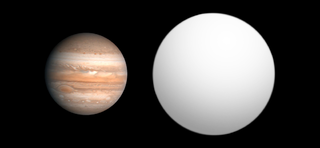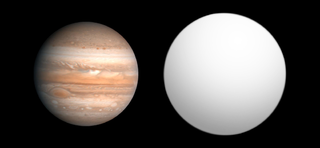
HD 209458 b is an exoplanet that orbits the solar analog HD 209458 in the constellation Pegasus, some 157 light-years from the Solar System. The radius of the planet's orbit is 0.047 AU, or one-eighth the radius of Mercury's orbit. This small radius results in a year that is 3.5 Earth-days long and an estimated surface temperature of about 1,000 °C. Its mass is 220 times that of Earth and its volume is some 2.5 times greater than that of Jupiter. The high mass and volume of HD 209458 b indicate that it is a gas giant.

Hot Jupiters are a class of gas giant exoplanets that are inferred to be physically similar to Jupiter but that have very short orbital periods. The close proximity to their stars and high surface-atmosphere temperatures resulted in their informal name "hot Jupiters".

An exomoon or extrasolar moon is a natural satellite that orbits an exoplanet or other non-stellar extrasolar body.

WASP-1b is an extrasolar planet orbiting the star WASP-1 located 1,300 light-years away in the constellation Andromeda.

WASP-2b is an extrasolar planet orbiting the star WASP-2 located about 500 light years away in the constellation of Delphinus. It was discovered via the transit method, and then follow up measurements using the radial velocity method confirmed that WASP-2b was a planet. The planet's mass and radius indicate that it is a gas giant with a similar bulk composition to Jupiter. Unlike Jupiter, but similar to many other planets detected around other stars, WASP-2b is located very close to its star, and belongs to the class of planets known as hot Jupiters. A 2008 study concluded that the WASP-2b system is a binary star system allowing even more accurate determination of stellar and planetary parameters.

WASP-3b is an extrasolar planet orbiting the star WASP-3 located approximately 800 light-years away in the constellation Lyra. It was discovered via the transit method by SuperWASP, and follow up radial velocity observations confirmed that WASP-3b is a planet. The planet's mass and radius indicate that it is a gas giant with a similar bulk composition to Jupiter. WASP-3b has such an orbital distance around its star to classify it in the class of planets known as hot Jupiters and has an atmospheric temperature of approximately 1983 K.

WASP-5b is an exoplanet orbiting the star WASP-5 located approximately 1000 light-years away in the constellation Phoenix. The planet's mass and radius indicate that it is a gas giant with a similar bulk composition to Jupiter. The small orbital distance of WASP-5 b around its star means it belongs to a class of planets known as hot Jupiters. The planetary equilibrium temperature would be 1717 K, but the measured dayside temperature is higher, with a 2015 study finding 2500±100 K and a 2020 study finding 2000±90 K.
This page describes exoplanet orbital and physical parameters.

WASP-8b is an exoplanet orbiting the star WASP-8A in the constellation of Sculptor. The star is similar to the Sun and forms a binary star with a red dwarf star (WASP-8B) of half the Sun's mass that orbits WASP-8A 4.5 arcseconds away. The system is 294 light-years away and is therefore located closer to Earth than many other star systems that are known to feature planets similar to WASP-8b. The planet and its parent star were discovered in the SuperWASP batch -6b to -15b. On 1 April 2008, Dr. Don Pollacco of Queen's University Belfast announced them at the RAS National Astronomy Meeting.

WASP-8 is a binary star system 294 light-years away. The star system is much younger than the Sun at 300 million to 1.2 billion years age, and is heavily enriched in heavy elements, having nearly twice the concentration of iron compared to the Sun.
WASP-10 is a star in the constellation Pegasus. The SuperWASP project has observed and classified this star as a variable star, perhaps due to the eclipsing planet.

WASP-11b/HAT-P-10b or WASP-11Ab/HAT-P-10Ab is an extrasolar planet discovered in 2008. The discovery was announced by press release by the SuperWASP project in April 2008 along with planets WASP-6b through to WASP-15b, however at this stage more data was needed to confirm the parameters of the planets and the coordinates were not given. On 26 September 2008, the HATNet Project's paper describing the planet which they designated HAT-P-10b appeared on the arXiv preprint server. The SuperWASP team's paper appeared as a preprint on the Extrasolar Planets Encyclopaedia on the same day, confirming that the two objects were in fact the same, and the teams agreed to use the combined designation.

WASP-12b is a hot Jupiter orbiting the star WASP-12, discovered on April 1, 2008, by the SuperWASP planetary transit survey. The planet takes only a little over one Earth day to orbit its star, in contrast to about 365.25 days for the Earth to orbit the Sun. Its distance from the star is only the Earth's distance from the Sun, with an eccentricity the same as Jupiter's. Consequently, it has one of the lowest densities for exoplanets. On December 3, 2013, scientists working with the Hubble Space Telescope (HST) reported detecting water in the atmosphere of the exoplanet. In July 2014, NASA announced finding very dry atmospheres on three exoplanets orbiting sun-like stars.

WASP-14b is an extrasolar planet discovered in 2008 by SuperWASP using the transit method. Follow-up radial velocity measurements showed that the mass of WASP-14b is almost eight times larger than that of Jupiter. The radius found by the transit observations show that it has a radius 25% larger than Jupiter. This makes WASP-14b one of the densest exoplanets known. Its radius best fits the model of Jonathan Fortney.

WASP-15b, formally named Asye, is an extrasolar planet discovered in 2008 by the SuperWASP collaboration, which seeks to discover exoplanets that transit their host stars. The planet orbits its host star at a distance of 0.05 AU every four days. The mass of this planet is about one half that of Jupiter, but its radius is nearly 50% larger than Jupiter's, making the density of this planet only one quarter that of water; it is thought that some other form of heating must explain its extremely low density. WASP-15b's discovery was published on April 29, 2009.
WASP-43 is a K-type star about 284 light-years away in the Sextans constellation. It is about half the size of the Sun, and has approximately half the mass. WASP-43 has one known planet in orbit, a Hot Jupiter called WASP-43b. At the time of publishing of WASP-43b's discovery on April 15, 2011, the planet was the most closely orbiting Hot Jupiter discovered. The small orbit of WASP-43b is thought to be caused by WASP-43's unusually low mass. WASP-43 was first observed between January and May 2009 by the SuperWASP project, and was found to be cooler and slightly richer in metals than the Sun. WASP-43 has also been found to be an active star that rotates at a high velocity.
WASP-24b is a Hot Jupiter detected in the orbit of the F-type star WASP-24. The planet is approximately the same size and mass of Jupiter, but it orbits at approximately 4% of the mean distance between the Earth and the Sun every two days. WASP-24b was observed by SuperWASP starting in 2008; after two years of observations, follow-ups led to the collection of the information that led to the planet's discovery.
WASP-44b is a closely orbiting Jupiter-sized planet found in the orbit of the sunlike star WASP-44 by the SuperWASP program, which searches for transiting planets that cross in front of their host stars as seen from Earth. After follow-up observations using radial velocity, the planet was confirmed. Use of another telescope at the same observatory detected WASP-44 transiting its star. The planet completes an orbit around its star every two and a half days, and orbits at roughly 0.03 AU from its host star. WASP-44b's discovery was reported by the Royal Astronomical Society in May 2011.
WASP-44 is a G-type star in the constellation Cetus that is orbited by the Jupiter-size planet WASP-44b. The star is slightly less massive and slightly smaller than the Sun; it is also slightly cooler, but is more metal-rich. The star was observed by SuperWASP, an organization searching for exoplanets, starting in 2009; manual follow-up observations used WASP-44's spectrum and measurements of its radial velocity led to the discovery of the transiting planet WASP-44b. The planet and its star were presented along with WASP-45b and WASP-46b on May 17, 2011 by a team of scientists testing the idea that hot Jupiters tend to have circular orbits, an assumption that is made when the orbital eccentricity of such planets are not well-constrained.

WASP-121b, formally named Tylos, is an exoplanet orbiting the star WASP-121. WASP-121b is the first exoplanet found to contain water in an extrasolar planetary stratosphere. WASP-121b is in the constellation Puppis, and is about 858 light-years from Earth.














